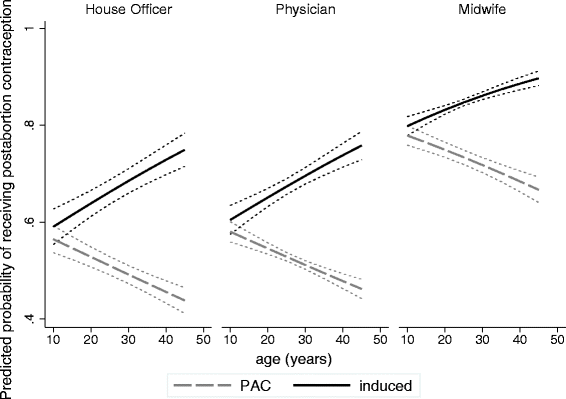Does the type of abortion provider influence contraceptive uptake after abortion? An analysis of longitudinal data from 64 health facilities in Ghana
- PMID: 26104025
- PMCID: PMC4478624
- DOI: 10.1186/s12889-015-1875-2
Does the type of abortion provider influence contraceptive uptake after abortion? An analysis of longitudinal data from 64 health facilities in Ghana
Abstract
Background: Understanding what factors influence the receipt of postabortion contraception can help improve comprehensive abortion care services. The abortion visit is an ideal time to reach women at the highest risk of unintended pregnancy with the most effective contraceptive methods. The objectives of this study were to estimate the relationship between the type of abortion provider (consultant physician, house officer, or midwife) and two separate outcomes: (1) the likelihood of adopting postabortion contraception; (2) postabortion contraceptors' likelihood of receiving a long-acting and permanent versus a short-acting contraceptive method.
Methods: We used retrospective cohort data collected from 64 health facilities in three regions of Ghana. The dataset includes information on all abortion procedures conducted between 1 January 2008 and 31 December 2010 at each health facility. We used fixed effect Poisson regression to model the associations of interest.
Results: More than half (65 %) of the 29,056 abortion clients received some form of contraception. When midwives performed the abortion, women were more likely to receive postabortion contraception compared to house officers (RR: 1.18; 95 % CI: 1.13, 1.24) or physicians (RR: 1.21; 95 % CI: 1.18, 1.25), after controlling for facility-level variation and client-level factors. Compared to women seen by house officers, abortion clients seen by midwives and physicians were more likely to receive a long-acting and permanent rather than a short-acting contraceptive method (RR: 1.46; 95 % CI: 1.23, 1.73; RR: 1.58; 95 % CI: 1.37, 1.83, respectively). Younger women were less likely to receive contraception than older women irrespective of provider type and indication for the abortion (induced or PAC).
Conclusions: When comparing consultant physicians, house officers, and midwives, the type of abortion provider is associated with whether women receive postabortion contraception and with whether abortion clients receive a long-acting and permanent or a short-acting method. New strategies are needed to ensure that women seen by physicians and house officers can access postabortion contraception and to ensure that women seen by house officers have access to long-acting and permanent contraceptive methods.
Figures

References
-
- Ghana Statistical Service (GSS), Ghana Health Service (GHS), and ICF Macro. Ghana Demographic and Health Survey 2008: Key Findings. Calverton, Maryland, USA; 2009.
-
- Ghana Statistical Service (GSS), Ghana Health Service (GHS), and Macro International Ghana Maternal Health Survey 2007. GSS, GHS, and Macro International. Calverton, Maryland, USA; 2009.
-
- Aryeetey R, Kotoh A, Hindin M. Knowledge, perceptions and ever use of modern contraception among women in the Ga East District, Ghana. Afr J Reprod Health. 2011;14(4):26–31. - PubMed
MeSH terms
Substances
LinkOut - more resources
Full Text Sources
Other Literature Sources
Medical

